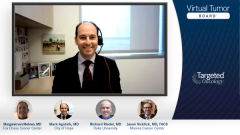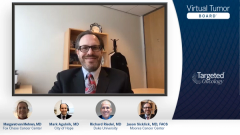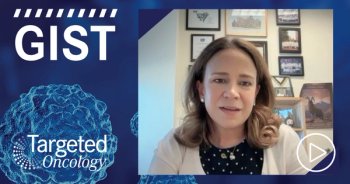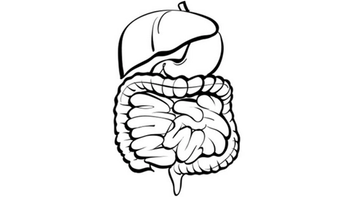
Case 2: The Role of Imatinib in GIST
The experts discuss the use of imatinib in patients with KIT exon 9-mutated GIST. Additionally, they comment on surgical options for patients with GIST.
Episodes in this series

Margaret von Mehren, MD: For this particular patient who had an exon 9 mutation, do you start at 400 mg? What do you do for that patient?
Mark Agulnik, MD: The real world in my practice has always been that I don’t know it’s an exon 9 mutation until after I’ve already started the imatinib because I would be sequencing afterward. Often if I start, then it depends on how far along. If I’m 4 weeks in, then maybe I get a scan at another 4 weeks and try to keep them on 400 mg without causing extra adverse effects. I know the data suggest that these patients would get a better response to 800 mg. In the neoadjuvant setting, though, I see whether I could still get the amount with 400 mg. If I knew up front, I would be intrigued to start them at 800, however, though.
Margaret von Mehren, MD: If I know they’re an exon 9, I do escalate them to 800 or 400 mg twice a day, just how they take it. But you’re right; most of the time they’ve already initiated their therapy, and they’re on. Even if I haven’t started their therapy and they have an exon 9, I actually always do start them at 400 and then escalate them.
From the initial studies that compared 400 with 800 mg, the patients who started at 800 or 400 mg twice a day had more adverse effects. But when you compared what happened with the patients who were on the low dose and then were escalating at the time of progression, their toxicity profile was much improved. Patients do get used to being on therapy, so I usually will give it for a month and then increase it to 400 mg twice a day.
Richard Riedel, MD: In my practice I routinely will start at 400 mg once a day. If I know that they’re an exon 9 mutation—Mark, to your point—I’m intrigued about the possibility of increasing to twice-daily dosing. For most of my patients though, I stay at once-daily dosing until I get to that first imaging study.
With that in mind, let’s say this individual received imatinib 400 mg daily. Mark, you mentioned that you like to maximize response. How do you counsel patients on how long that could be?
Mark Agulnik, MD: I tell them that I see everything in blocks of 3 months and that we make decisions every 3 months, and that we’re not looking too far ahead. Also, I always work with surgeons so that we have the same messaging to the patients. Essentially, the moment we see stabilization of disease—likely not growth, but as soon as we see stabilization of disease—that’s the time period we’re going to take them to surgery.
If we also knew that the patient was going to receive 3 years of adjuvant therapy, I tell them it doesn’t matter how much they get up front vs how much they get afterward. We create this package together, and that’s how I bridge it for them. For the average patient in my practice, it’s been about 9 months before we’ve taken them to surgery, and that’s typically how we’ve done it for them and counseled them accordingly.
Margaret von Mehren, MD: I always tell them they’re not going to go to surgery before 6 months. Most people will have some benefit at 3 months, so I say I want to see it stable and no longer shrinking. I say you can anticipate being on therapy for at least 6 months and then we’ll see, giving them the goal of what it is that we’re looking for to have your tumor decrease in size and stabilize before going to surgery, unless the surgeon says it’s at a point that makes sense. Jason, you don’t have to wait until it shrinks to the tiniest thing.
Jason Sicklick, MD, FACS: Right. We’ll generally tell the patients in our counseling with them that it’s about 6 to 9 months, sometimes going out even as long as a year on rare occasion. Really, it’s a matter of seeing that the tumor is responding. It’s 1 of 2 things: either plateaued out where don’t see any more response and so we’ve hit our maximal benefit at that point, or as Meg mentioned, even if it shrinks another centimeter or less or more, it’s not going to change the operation in the way it’s being conducted.
It’s not going to make it any easier or any safer. At that point, we would then plan or schedule for surgery based on timing in this day and age with COVID-19 and trying to get the patients into the operating department in a safe manner. But it’s often not a rush at that point either.
In general, the times we do give neoadjuvant therapy, it often makes a difference. We’re trying to wait to get the maximal responses either in the tumors that are right at the GE [gastroesophageal] junction or the esophagus, the larger rectal tumors where it might convert from a low anterior resection or an abdominal peroneal resection to just an actual wedge resection of the rectum with the primary closure.
Lastly, the duodenal tumors might be able to convert it from being a pancreatic or duodenectomy to just a duodenal resection with a small bowel anastomosis. Those are the common sites where really size does often matter, and it does make a difference in terms of the way that operation is performed.
Richard Riedel, MD: In my practice, I will routinely tell patients it can take up to 12 months to maximize shrinkage. I do get concerned if I don’t see any shrinkage after 6 months. I’ll work collaboratively with my surgeon just to keep them in the loop. We’ll review the images at our conference. Meg, to your point, I don’t necessarily need to maximize shrinkage. If my surgeon tells me that it doesn’t need to shrink anymore or that if it shrunk more, it wouldn’t change the nature of the operation, then we’ll take them at that point.
Transcript edited for clarity.













































